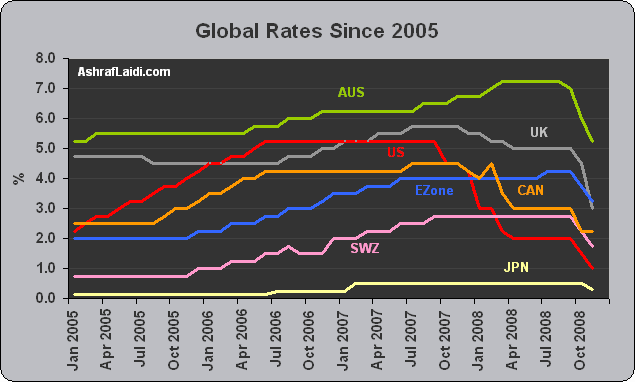Global Interest Rates
Telling the Interest Rate Story

Interest rates are the single most important fundamental driver in Forex and the direction of monetary policy is essential in shaping developments in currencies. This direction is determined by the vast array of economic reports, central bank rhetoric and movements in equity and bond markets. Knowing where the various interest rates stand is not enough by itself. Instead, assessing where each nations monetary policy is heading relative to others is paramount in getting the best bang out of your buck in selecting the appropriate foreign exchange pair.
The chart shows the interest rate path of 6 central banks since 2002. The much discussed carry trade (selling low yielding currencies to purchase in higher yielding ones) was its strongest between 2005 and 2007 when Japanese interest rates remained below 1.00% while all other central banks began raising rates. The rate hikes of the U.S., Australia, Canada and the Eurozone were particularly aggressive during the period, allowing their currencies to post sharp gains versus the yen.
The Japanese yen and Swiss franc are characterized by their low-yielding status, but the yen is more notorious for its sharp declines during the accumulation of carry trades as well as for its rapid gains during the unwinding of carry trades. The main reason is the size of the Japanese economy, whose GDP of $4.3 trillion is the worlds second largest. More significantly, only 1 to 2 % of Japans 1,500 trillion yen (US$13 trillion) in household financial assets is invested overseas, while the rest is desperately searching for higher yields in an economy with predominantly low interest rates. The Japanese search for foreign yield had begun with foreign currency deposits, which fell out of favor due to their high commissions and fees. Investors then shifted toward foreign bond funds, which offered higher yields as well as monthly dividend payments aimed not only at enhancing interest income but also to offset any potential decline in the value of the bonds.
Notably, individual Japanese investors upped the ante on exploiting rate differentials in 2004 as G5 nations were in the midst of normalizing interest rates upwards following the concerted rate cuts of 20012003. The rise of online-based foreign exchange margin trading enabled speculators to use leverage to control regular-size contracts with deposits 50 to 100 times less than normal size. With a 100 to 1 leverage, speculators can expand a 5 percent yield differential 500 times, magnifying the potential profit and risk of loss. The rate differential is then further enhanced or offset via the resulting currency fluctuations.
First in First out?

Taking a closer look at interest rate developments, we note that the US Federal Reserve preceded all other central banks (in the chart) in cutting interest rates (summer 2007), while other central banks were either tightening or on hold. This policy contrast was largely responsible for extending the dollar’s tumble in 2007 and part of 2008. But as the global slowdown intensified, central banks in Australia, UK, New Zealand and Canada were largely seen joining the Fed in slashing their interest rates. As the deepening economic slowdown in Europe, Japan and antipodean countries is perceived to be at its early stage relative to that of the US, markets reason that the US may be the first to slow and first to recover (first in first out), prompting the sharp August rally in the US dollar.
This theme is clearly illustrated in the accompanying interest rate chart, showing US rates unchanged since April, following 225-bps of easing, standing below all other interest rates with the exception of Japan. Markets expect the easing campaigns to resume in the UK, Canada and New Zealand, while the Reserve Bank of Australia, is expected to begin easing in Q4. The European Central Bank and Swiss National Bank are seen to start their easing campaign in early 2009.
US Interest Rates Minus the Rest

Assessing the global interest rate story from a US perspective, the chart below suggests the eroding interest rate differential may have reached its worst thanks to US rates being unchanged since April while other nations’ rates have been cut since then (UK, Canada and New Zealand). And even if the Federal Reserve were forced to cut rates later this year, it would have to do so due to clear economic deterioration, in which case may also drive other central banks to ease. The exception to this assumption is in the event that further rate cuts are a result of deepening corrosion in US-specific dynamics (renewed housing slump, accelerating unemployment, deteriorating consumption and re-emerging worries to the financial system). Such would be a repeat of conditions in mid June into early July when escalating worries dragged US and global stocks as well as the dollar.







